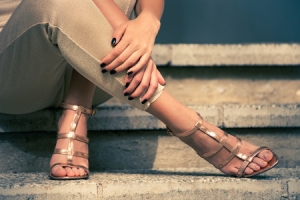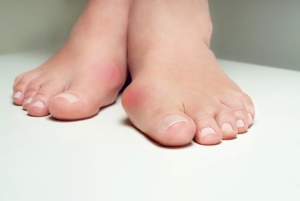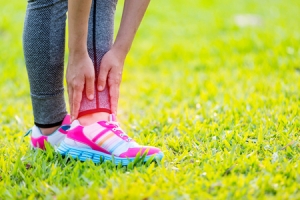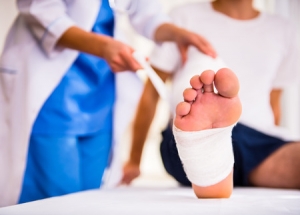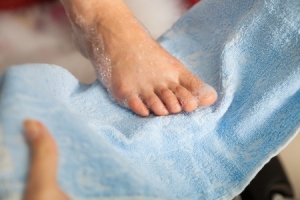Connect With Us
Blogs
Displaying items by tag: bunion
Do You Like How Your Feet Look?
Are you comfortable wearing strappy sandals or open-style shoes? If not, does the appearance of your feet have something to do with it? At Superior Foot & Ankle Care Center, we know that several podiatric disorders have unsightly outward signs that can make female patients feel self-conscious about wearing individual shoe styles. Below are some of the most common ones and what you can do about them.
Bunions—a large bump at the base of the big toe is the telltale sign of a bunion. While many patients know how to recognize a bunion, there is a lack of understanding about the condition. A bunion is a progressive condition, meaning it will only get worse over time. That’s why at the first sign of a bunion it’s important that you make an appointment at our Long Beach office (562-420-9800) so that our podiatrists, Dr. Victoria M. Foley or Dr. Constance Ornelas can evaluate it. The foot doctor may want to take an x-ray to use to monitor the progression of the bunion. There are several conservative treatment options available, although only surgery can correct a bunion. The podiatrist will recommend the best treatment based on your individual case.
Haglund’s Deformity—perhaps you know this condition by its more common name—pump bump. A bony enlargement at the back of the heel distinguishes it. When pumps or other shoes with stiff backs rub against the bony protrusion, it can become inflamed and red, causing pain and discomfort. Wearing open-backed shoes and using heel lifts can both help reduce the irritation.
Fungal Toenails—a brownish discoloration of a toenail, along with thickening and crumbling edges can signal a fungal toenail. Although these are often not painful, they are unattractive and can spread to other nails if left untreated. Topical, oral, and laser therapy are all possible treatments for eradicating fungal nails.
You don’t have to hide your feet. If you have a condition that is causing you to want to keep your feet hidden away, contact us and let us help you restore your feet’s natural beauty.
What’s Behind Bunions?
At first, a bunion may appear very subtle. You may look down and notice your big toe seems to be leaning slightly toward the second toe. At Superior Foot & Ankle Care Center, we find many patients are unfamiliar with how bunions develop and therefore may not come in promptly to get them evaluated.
Know Your Risk Factors
Most often, bunions are caused by a biomechanical defect in your feet. This may be a neuromuscular problem, flat feet or overpronation. In many instances, this fault in the mechanics of your feet may be inherited. There are other factors, however, that can also increase your risk of developing a bunion, including:
- Wearing tight-fitting shoes with pointy or narrow toe boxes
- Spending long periods of time in high-heeled shoes or boots
- A previous foot injury
- Congenital defect
- Repetitive stress to the foot
- Arthritis
Seek Treatment Early
In its early stages, a bunion may not cause you any pain or discomfort. However, bunions are a progressive disorder. As time goes on, the big toe joint will move further and further out of place until it begins to cause pain when you walk. It will also become increasingly difficult to wear shoes due to the pressure exerted on the bunion by your footwear. The toe can eventually become rigid in the defective position and cause other deformities such as hammertoes to occur. It’s essential that you make an appointment at our Long Beach office so that our podiatrists, Dr. Victoria M. Foley or Dr. Constance Ornelas can examine your foot. Fortunately, there are many treatment options available which can slow the progression of the bunion and prevent foot pain and discomfort. These include:
- Altering your activities to avoid motion that exerts adverse pressure on the bunion
- Using a custom orthotic to correct the biomechanical problem and increase stability
- Exercises to increase joint mobility
- Night splints to realign the joint
If you think you have a bunion forming, don’t wait. Contact us today for an appointment by calling: (562) 420-9800.
Common Reasons Exercise Programs Fail
At Superior Foot & Ankle Care Center we know the importance of exercise to your feet as well as the rest of your body. That’s why we applaud patients who make a resolution to get in shape in the New Year. Too often, however, by the time February rolls around many exercise plans have already been shelved. Below are some scenarios that can bring fitness plans to a halt and how to work around them.
“Let’s do this! I am going to work out every day to get in shape fast no matter what it takes.”
Not so fast, or you’ll likely end up with an injury. Achilles tendonitis, ankle sprains, and shin splints are just a few of the conditions that can be caused by doing too much too quickly. Not to mention that an overly ambitious start, especially if you’re out of shape, can lead to fatigue and discouragement before you even really get started. The best bet for long-term success is to do an activity or program that allows you to start slowly and gradually increase the level of your workout.
“I started a running program a few years ago and still have my shoes—yay! I won’t have to go out and buy new ones.”
Footwear is one of the most important factors in the success of an exercise program. Getting fitness shoes that are designed for the sport or activity, you’ll be doing is key. However, foot size can change over time. It’s best to get your foot measured professionally and try your shoes on to make sure they are still comfortable.
“I have a bunion, but I think if I put a pad over it I should be able to exercise without a problem.”
Before starting a new exercise program, it’s always best to consult your general practitioner and also your podiatrist. Our foot doctors, Dr. Victoria Foley or Dr. Constance Ornelas, will examine your feet completely. If you have a chronic foot problem, the podiatrist can recommend shoe styles and make suggestions for how to best accommodate your condition. In some cases, a custom orthotic device can increase comfort and performance.
“I’m going to join a gym—there are lots of good deals available now.”
Take the time to consider your likes and lifestyle. A gym is a good option if you like the classes and machines offered and you need to schedule around your work. Consider if you want a more social setting or if you like to work out alone, if you prefer an indoor or outdoor activity and how much time you can devote to your fitness plan. You’re more likely to stick to a plan that suits your interests and your availability.
If you experience any foot or ankle pain or discomfort when exercising, contact our Long Beach office by calling: (562) 420-9800.
All Your Feet Want for Christmas
Dear Santa,
In the weeks leading up to the holidays, we have been working extra hard and trying our best to do everything we are asked to do. We have walked the mall looking for the best gifts, stood on line at the post office mailing cards and packages, attended several festivities and been putting in extra hours for house cleaning and cooking. Below is a list of gifts we are requesting:
- A visit to Superior Foot & Ankle Care Center. We’ve been hurting for a while now and the added pressure of the holidays has only increased our discomfort. We know that foot doctors, Dr. Victoria Foley, and Dr. Constance Ornelas will examine us and be able to provide a prompt diagnosis and treatment plan for what’s causing our pain.
- New shoes. We have a few comfy favorites, but honestly, they are getting a little worn out. The backs are stretched, and there is some frayed stitching on the toe that I am afraid is going to cause a trip or fall. In addition, it’s time to ditch some of the high heels and shoes with pointy toes—they are making our toes hurt, and we are worried that wearing them may cause a bunion to develop. We need to be professionally measured too because, over time, foot size can change.
- Professional pedicure. It would be relaxing to soak in a warm bath and then have my nails trimmed and polished in a festive color for the holidays. Of course, that’s only if the salon follows all the proper sanitizing procedures for sterilizing foot baths and nail tools so that we don’t end up with a fungal infection.
- Extra emollient moisturizer. With the heat on all the time, our skin is getting pretty dry. Flakes and itching are annoying enough, but we certainly don’t want to get to the point where cracks are opening in our heels. Thick and rich cream or lotion to put on our feet would be much appreciated. In addition, maybe a pair of fleece socks to put on after the lotion is applied would be great if it’s not too much to ask.
Are your feet trying to tell you something? If you have questions about unusual podiatric symptoms, you are experiencing or want to learn more ways to be proactive in caring for your feet, contact our Long Beach office today by calling: (562) 420-9800.
Post Op Pointers for Speedy Healing
At Superior Foot & Ankle Care Center we are committed to helping patients obtain relief from foot and ankle disorders using the least invasive methods possible. Sometimes, however, when conservative methods fail to give good results or a condition has progressed to a certain point, surgery is the best treatment option. Whether your surgery is to correct a bunion or help with flat feet, plantar fasciitis or another podiatric condition, what happens after the surgery is critical to completing the healing process. Below are some areas you should focus on if you are planning or have recently had podiatric surgery:
Plan Ahead—our feet are so crucial to daily living and yet we often take them for granted. If you will be unable to walk, even for a short period of time, you will need to put certain things into place prior to surgery:
- See that the area where you will be recovering has everything in easy reach—T.V. remote, books, water, phone, etc. If you sleep upstairs, you may need to set up a temporary bedroom on your main floor.
- Accept all offers of help for meals, running errands or caring for children.
- Clear your calendar of work and other appointments and obligations. Regardless of mobility, you will need rest immediately after surgery.
Wound Care—one of the most critical aspects of surgical recovery is preventing an infection from developing. Be sure you understand and follow all your foot doctor’s instructions for keeping surgical wounds clean. If you notice any signs of infection—warmth at the site of the surgery, redness or red streaks around the wound or fever—contact our podiatrists, Dr. Victoria Foley or Dr. Constance Omelas, immediately, even if it is after regular office hours.
Follow Through—don’t be your own foot doctor! Follow all of the podiatrist’s guidelines for your recovery and complete the full course of any physical therapy that is prescribed. Too often patients will discontinue therapy when they are feeling pain-free, but particularly for foot and ankle injuries strengthening of surrounding muscles and ligaments is necessary for full recovery. If you have any questions concerning post-operative care instructions or symptoms you experience after surgery don’t hesitate to contact our Long Beach office by calling: 562-420-9800.
Diabetes: Making Positive Choices
At Superior Foot & Ankle Care Center we know that diabetes doesn’t have to prevent you from living a full and active life. We treat many patients with this disease and we know it can have a big impact on the health of your feet. Diabetes impedes the circulatory and immune systems increasing the likelihood of infections and decreasing the body’s ability to heal. To make matters worse, neuropathy, a condition also commonly associated with diabetes, makes it difficult to perceive sensations like pain or heat which would signal a potential wound. The good news is there’s much you can do to protect your feet. In recognition of National Diabetes Awareness Month we’d like to focus on some particularly important areas:
Foot Care—Your feet can be both a recipient and an early warning system with regard to problems with diabetes. For that reason, inspecting your feet on a daily basis is essential. Changes in skin or nails, lumps, swelling, bruises, redness, blisters can all signal a potential problem developing. It’s critical that one of our foot doctors, Dr. Victoria Foley or Dr. Constance Omelas be informed of any unusual changes immediately. A good care regimen can also help decrease the risk of foot problems in diabetic patients. Wash feet with a mild soap in warm—not hot—water and dry completely, especially between your toes.
Shoes—Although well-made, properly fitted shoes can help reduce the risk of foot disorders in all patients, those with diabetes have specific concerns to address. Look for shoes that are well cushioned to reduce impact to the soles of your feet. Shoes should be laced and fit snugly (but not tight) to provide stability and limit side to side movement of the foot. If you have a toe deformity such as a bunion or hammertoe, special padding may be prescribed to prevent rubbing and friction which could lead to a corn or callus. Be sure the front of the shoe is roomy to prevent toes from being squeezed together.
Keep Feet Dry—Damp feet can lead to a fungal infection. If you tend to sweat profusely you can use a foot powder or even antiperspirant on the soles of your feet to reduce wetness. Change socks whenever you notice they are damp.
Healthy Lifestyle—Follow your doctor’s instructions for controlling your diabetes. Don’t smoke (it will further impede your circulation). Eat a healthy diet that is high in protein, vegetables and whole grains and limits saturated and trans fats and sugars. Exercise regularly for good joint health and weight control.
If you have additional questions about foot health and diabetes, contact our Long Beach office by calling: 562-420-9800.
